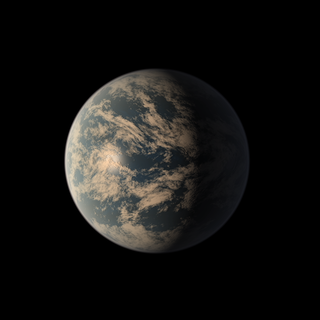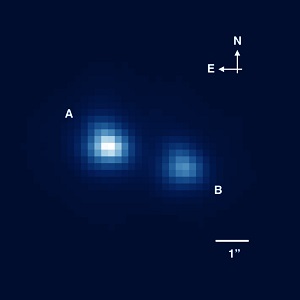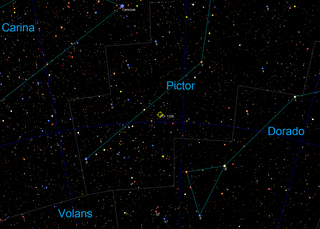This article may require cleanup to meet Wikipedia's quality standards. The specific problem is: Many sections need to be filled in or if too hard to fill in, delete the section header.(October 2018) |
This is a list of exceptional red dwarfs.
This article may require cleanup to meet Wikipedia's quality standards. The specific problem is: Many sections need to be filled in or if too hard to fill in, delete the section header.(October 2018) |
This is a list of exceptional red dwarfs.
This is a list of red dwarfs that currently hold records.
| Record Title | Star | Date | Data | Notes | |
|---|---|---|---|---|---|
| First discovered | Lacaille 8760 | 1753 | Originally listed in a 1763 catalog that was published posthumously by Abbé Nicolas Louis de Lacaille. | [1] | |
| First discovered with planet(s) | Gliese 876 | 1998 | Gliese 876 b | The Jovian planet was the first discovered around a red dwarf. | [2] [3] |
| First discovered with giant planet(s) | Gliese 876 | 1998 | Gliese 876 b | The giant planet was the first planet discovered around a red dwarf. | [2] [3] |
| First discovered with terrestrial planet(s) | Kepler-42 (KOI-961) | 2012 | KOI-961 b KOI-961 c KOI-961 d | 3 terrestrial planets were discovered around KOI-961 in 2012, the first terrestrial planets found to orbit a red dwarf. | [4] |
| Record Title | Star | Date | Data | Notes | References |
|---|---|---|---|---|---|
| Least voluminous | EBLM J0555-57Ab | 2017 | r= 59,000 km (37,000 mi) | [5] | |
| Most voluminous | XZ Tauri B | 2002 | 1.7 R☉ | [6] | |
| Least massive | 2MASS J0523-1403 | 2015 | 67.54±12.79 MJ | [7] | |
| Most massive | Kepler-80 | 2012 | 0.73 M☉ | [8] | |
| Least distant | Proxima Centauri | 1917 | 4.2 ly (1.3 pc ) | This is also known as Alpha Centauri C and is a member of the α Cen trinary system. It is the nearest neighbouring star to the Sun. | [9] |
| Most distant | UDF 3561 | 2010 | 202,000 ly (62,000 pc) | [10] | |
| Least luminous | 2MASS J0523-1403 | [7] | |||
| Most luminous | |||||
| Dimmest | UDF 2457 | V= 25 | [11] | ||
| Brightest | Lacaille 8760 | V= 6.69 | Also called AX Microscopii. This is the 24th closest star to the Sun, and also intrinsically luminous for red dwarfs, having spectral class M0. | [12] [13] | |
| Youngest | See T Tauri star | ||||
| Oldest | |||||
This is a list of red dwarfs with names that are not systematically designated.
| Star | Naming | Notes | |
|---|---|---|---|
| Proxima Centauri | Named for being the closest neighbouring star to Earth's Sun | Lies within the Alpha Centauri star system | [9] |
| Barnard's Star | Named after its discoverer, E. E. Barnard | Second closest neighbouring star system to Earth, after α Cen. Also the star with the highest proper motion. | [14] |
| van Biesbroeck's star | Named for its discoverer, George van Biesbroeck | Was once the least luminous, and, lowest mass, known star. | [15] |
| Kapteyn's star | Named for the astronomer who discovered it had gone missing, Jacobus Kapteyn | Was once the star with the highest proper motion, thus making it move away from its recorded position in the sky and go "missing". | [14] |
| Teegarden's Star | Named after the lead investigator astrophysicist who discovered it, Bonnard J. Teegarden, through a datacrunching search of archived data. | ||
| Star | Distance ly (pc) | Notes | ||
|---|---|---|---|---|
| 1 | Proxima Centauri | 4.2 ly (1.3 pc) | Part of the α Cen trinary system, the closest neighbouring star system. It is also the nearest neighbouring star. | [9] |
| 2 | Barnard's Star | 5.95 ly (1.82 pc) | Second closest neighbouring star system | [16] |
| 3 | Wolf 359 | 7.86 ly (2.41 pc) | Also called CN Leonis | |
| 4 | Lalande 21185 | 8.3 ly (2.5 pc) | ||
| 5 | Luyten 726-8 | 8.7 ly (2.7 pc) | This is a binary star system with two red dwarfs | |
| 6 | Ross 154 | 9.68 ly (2.97 pc) | [ citation needed ] | |
| Star | Radius Solar radii (Sun = 1) | Radius Jupiter radii (Jupiter = 1) | Radius km (mi) | Notes | ||
|---|---|---|---|---|---|---|
| 1 | EBLM J0555-57Ab | 0.084 | 0.84 | 59,000 km (37,000 mi) | This star is slightly larger than the planet Saturn. | [17] [18] [19] |
| 2 | 2MASS J0523-1403 | 0.086 | 0.86 | 60,000 km (37,000 mi) | [20] [21] [22] | |
This is a list of titleholders of being the red dwarf with the smallest volume, and its succession over time.
| Star | Date | Radius Solar radii (Sun = 1) | Radius Jupiter radii (Jupiter = 1) | Radius km (mi) | Notes | |
|---|---|---|---|---|---|---|
| EBLM J0555-57Ab | 2017— | 0.084 | 0.84 | 59,000 km (37,000 mi) | This star is slightly larger than the planet Saturn. | [17] [18] [19] |
| 2MASS J0523-1403 | 2013-2017 | 0.086 | 0.86 | 60,000 km (37,000 mi) | [20] [21] [22] | |
| OGLE-TR-122B | 2005-2013 | 0.120 | 1.16 | 81,100 km (50,400 mi) | [23] [24] [25] | |

WASP or Wide Angle Search for Planets is an international consortium of several academic organisations performing an ultra-wide angle search for exoplanets using transit photometry. The array of robotic telescopes aims to survey the entire sky, simultaneously monitoring many thousands of stars at an apparent visual magnitude from about 7 to 13.
HAT-P-6 also named Sterrennacht is a star in the constellation Andromeda, located approximately 895 light years or 274 parsecs away from the Earth. It is an F-type star, implying that it is hotter and more massive than the Sun. The apparent magnitude of the star is +10.54, which means that it can only be visible through the telescope. The absolute magnitude of +3.36 is brighter than the Sun's +4.83, meaning that the star itself is brighter than the Sun. A search for a binary companion star using adaptive optics at the MMT Observatory turned out negative.
Blanco 1 is a nearby open cluster of stars located around 850 light years away from the Sun in the southern constellation of Sculptor near the star ζ Sculptoris. It was discovered by Puerto Rican astronomer Víctor Manuel Blanco in 1949, who noticed an unusually high proportion of A-type stars in an area spanning 1.5°. This cluster is relatively young, with an age of about 100–150 million years. It is positioned at a high galactic latitude of b = –79.3° and is located some 780 ly (240 pc) below the galactic plane.

TRAPPIST-1d, also designated as 2MASS J23062928-0502285 d, is a small exoplanet, which orbits on the inner edge of the habitable zone of the ultracool dwarf star TRAPPIST-1, located 40.7 light-years away from Earth in the constellation of Aquarius. The exoplanet was found by using the transit method, in which the dimming effect that a planet causes as it crosses in front of its star is measured. The first signs of the planet were announced in 2016, but it wasn't until the following years that more information concerning the probable nature of the planet was obtained. TRAPPIST-1d is the second-least massive planet of the system and is likely to have a compact hydrogen-poor atmosphere similar to Venus, Earth, or Mars. It receives just 4.3% more sunlight than Earth, placing it on the inner edge of the habitable zone. It has about <5% of its mass as a volatile layer, which could consist of atmosphere, oceans, and/or ice layers. A 2018 study by the University of Washington concluded that TRAPPIST-1d might be a Venus-like exoplanet with an uninhabitable atmosphere. The planet is an eyeball planet candidate.

EBLM J0555-57 is a triple star system approximately 670 light-years from Earth. EBLM J0555-57Ab, the smallest star in the system, orbits its primary star with a period of 7.8 days, and currently is the smallest known star with a mass sufficient to enable the fusion of hydrogen in its core.

TOI-1338 is a binary star system located in the constellation Pictor, about 1,320 light-years from Earth. It is orbited by two known circumbinary planets, TOI-1338 b, discovered by the Transiting Exoplanet Survey Satellite (TESS) and BEBOP-1c, discovered by the Binaries Escorted By Orbiting Planets project.
WASP-76, also known as BD+01 316, is a yellow-white main sequence star in the constellation of Pisces. Since 2014, it has had one suspected stellar companion at a projected separation of 85 astronomical units.
WASP-32 is a yellow main-sequence star in the constellation of Pisces. The star was given the formal name Parumleo in January 2020, Latin for small lion and referencing the national animal of Singapore.
K2-315b is an exoplanet located 185.3 light years away from Earth in the southern zodiac constellation Libra. It orbits the red dwarf K2-315.
WASP-59 is a K-type main-sequence star about 379 light-years away. The star's age is essentially unconstrained by observations. WASP-59 is slightly depleted in heavy elements, having 70% of the solar abundance of iron. The star produces extremely low levels of ultraviolet light, indicating an absence of flare activity.
WASP-69, also named Wouri, is a K-type main-sequence star 164 light-years away. Its surface temperature is 4782±15 K. WASP-69 is slightly enriched in heavy elements compared to the Sun, with a metallicity Fe/H index of 0.10±0.01, and is much younger than the Sun at 2 billion years. The data regarding starspot activity of WASP-69 are inconclusive, but spot coverage of the photosphere may be very high.
WASP-84, also known as BD+02 2056, is a G-type main-sequence star 327 light-years away in the constellation Hydra. Its surface temperature is 5350±31 K and is slightly enriched in heavy elements compared to the Sun, with a metallicity Fe/H index of 0.05±0.02. It is rich in carbon and depleted of oxygen. WASP-84's age is probably older than the Sun at 8.5+4.1
−5.5 billion years. The star appears to have an anomalously small radius, which can be explained by the unusually high helium fraction or by it being very young.
WASP-90 is a faint 11th magnitude star located in the northern constellation Equuleus. With an apparent magnitude of 11.63, it is too faint to be detected with the naked eye, but can be seen with a telescope, and is located 1,540 ly (470 pc) from the Solar System.
{{cite magazine}}: Cite magazine requires |magazine= (help)